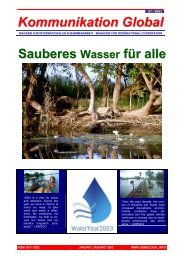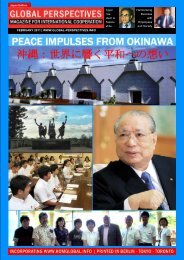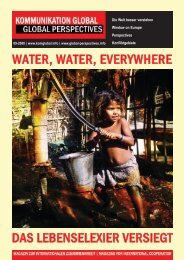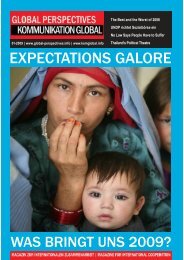GLOBAL PERSPECTIVES | Second Quarterly 2013 â North America ...
GLOBAL PERSPECTIVES | Second Quarterly 2013 â North America ...
GLOBAL PERSPECTIVES | Second Quarterly 2013 â North America ...
You also want an ePaper? Increase the reach of your titles
YUMPU automatically turns print PDFs into web optimized ePapers that Google loves.
<strong>GLOBAL</strong> <strong>PERSPECTIVES</strong> - SECOND QUARTERLY <strong>2013</strong><br />
ASIA<br />
Aiding Kachin State Entails Great Personal Risk<br />
By Sushetha Gopallawa*<br />
WASHINGTON DC - While in Myanmar's Kachin State in May, I visited a number of displacement camps around<br />
and I also met with Kachin community-based organizations (CBOs) who deliver aid in both government and nongovernment<br />
controlled areas.<br />
Over 100,000 people have<br />
been displaced since conflict<br />
between the Myanmar military<br />
and the Kachin Independence<br />
Army (KIA) resumed in<br />
June 2011. While about<br />
35,000 of these individuals are<br />
living in governmentcontrolled<br />
areas, more than<br />
half of the displaced are located<br />
behind rebel lines, in areas<br />
controlled by the Kachin Independence<br />
Organisation<br />
(KIO), the KIA’s political wing.<br />
The KIO have granted humanitarian<br />
agencies permission to<br />
enter their territory and deliver<br />
assistance. The Myanmar government, however, continues<br />
to block the UN and the international donors from<br />
accessing KIO-controlled areas. Thus the majority of internally<br />
displaced persons (IDPs) in Kachin State are largely<br />
dependent on local CBOs for their most basic needs – including<br />
shelter, food, health care, water and sanitation,<br />
access to medicines, education, and protection.<br />
For even the best equipped agencies, accessing IDP camps<br />
in KIO-controlled areas can prove difficult. Many camps are<br />
located in remote areas at high altitudes, and during the<br />
rainy season (which lasts from May to October), the roads<br />
become almost impassable. Supplies often need to be<br />
transported by mule, making the process slow and complicated,<br />
and hampering the ability of CBOs to do their lifesaving<br />
work.<br />
Geographically speaking, some parts of KIO territory are<br />
more easily accessed through China than through Myanmar.<br />
However, donor restrictions and Chinese border rules<br />
make aid delivery very challenging. China does not allow<br />
supplies bearing logos of foreign organizations to be transported<br />
across its borders, and it also restricts the shipment<br />
of food and medicines procured inside Myanmar through<br />
China to KIO-held areas. Most donor agencies, meanwhile,<br />
prohibit CBOs from purchasing supplies in China.<br />
These complex logistical issues force most CBOs in Kachin<br />
State to take incredible risks. During my time in the region,<br />
I heard many stories about the innovative – and often dangerous<br />
– steps that CBO staff take to reach those in need.<br />
Image credit: opensocietyfoundations.org<br />
Some hide in the forests and<br />
wait until nightfall, or until<br />
the Chinese border guards<br />
have left their posts, before<br />
crossing into KIO-controlled<br />
areas via China. They also<br />
collaborate with Kachin<br />
drivers living inside China to<br />
find back roads and avoid<br />
official border crossings.<br />
Still other CBO staff work<br />
with Chinese-based Kachin<br />
businessmen and traders to<br />
procure much needed supplies,<br />
and then store them<br />
until they are ready for<br />
transportation to the IDPs.<br />
Some of these CBO workers have been stopped and questioned<br />
by the Chinese border authorities. But if not for<br />
their work in rebel-held areas – at such grave personal risk<br />
– thousands of IDPs would receive barely any lifesaving<br />
assistance.<br />
Instead of directing aid through these courageous CBOs,<br />
some major donors and agencies – most notably the U.S.<br />
government – have decided to wait until the Myanmar<br />
government allows UN convoys to go behind rebel lines.<br />
These donors also maintain that many CBOs have limited<br />
capacities, lack accountability and are insufficiently transparent.<br />
But it could be weeks or months before official<br />
access to KIO zones is granted, so it is time for the donor<br />
community to think outside the box and be flexible in supporting<br />
these CBOs in the KIO-controlled areas. Indeed,<br />
they should also invest in capacity-building for these<br />
groups to help them meet international standards, rather<br />
than simply dismissing them.<br />
Without the incredible work being done by community<br />
organisations in KIO-controlled areas, the UN and the international<br />
community would have another humanitarian<br />
crisis on their hands in Kachin. But to keep the situation<br />
from getting worse, they will have to recognize these<br />
groups as real partners. [IDN | June 04, <strong>2013</strong>] <br />
*The writer, a former Sri Lanka foreign service officer,<br />
visited Myanmar’s Kachin State for Refugees International.<br />
Her report is reproduced with permission.<br />
- 17 -















